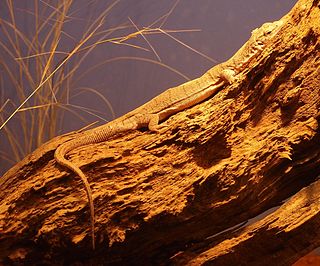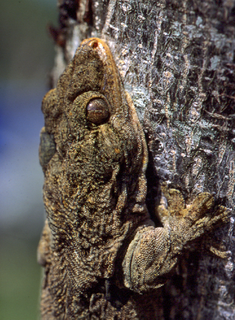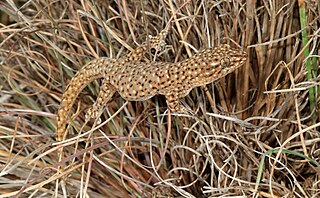
Gehyra is a genus of geckos in the family Gekkonidae. They are known as web-toed geckos or dtellas, and most species within the genus bear close resemblance to geckos from the genus Hemidactylus.

Ptenopus is a small genus of lizards, known commonly as barking geckos, in the family Gekkonidae. The genus is endemic to southern Africa. There are only three described species in this genus.

Gehyra mutilata, also known commonly as the common four-clawed gecko, Pacific gecko, stump-toed gecko, sugar gecko in Indonesia, tender-skinned house gecko, and butiki in Filipino, is a species of lizard in the family Gekkonidae. The species is native to Southeast Asia. It has made its way to several areas of the world including Sri Lanka, Indochina, and many of the Pacific Islands. Compared to the common house gecko, the appearance of G. mutilata is somewhat plump, with delicate skin. The skin is usually colored a soft purplish/pinkish gray, with golden spots on younger specimens; these spots eventually fade with age.

Hemidactylus brookii, also known commonly as Brooke's house gecko and the spotted house gecko, is a widespread species of lizard in the family Gekkonidae..

Cyrtodactylus rubidus is a species of gecko found in the Andaman Islands (India) and the Coco Islands (Myanmar). The type locality is Port Blair, Andaman Islands.
The Qattara gecko is a species of lizard in the family Phyllodactylidae.

Heteronotia binoei, also known commonly as the prickly gecko or Bynoe's gecko, is a species of lizard in the family Gekkonidae. The species is endemic to Australia. One of Australia's least habitat-specific geckos, it occurs naturally across much of the country, and has also established in areas where it does not occur naturally, such as urban Perth, Western Australia. It is dark brown to reddish brown, depending on the colour of the ground upon which it lives. There are irregular light bands with dark edges along its back.

The Okavango dwarf gecko or Chobe dwarf gecko is a species of gecko found along the Chobe and Zambesi Rivers and into the Okavango Delta, and into Mozambique, Zimbabwe and Zambia.
Christinus alexanderi, also known as Alexander's southern gecko or Alexander's marbled gecko, is a species of Gekkonidae geckos found in the Nullarbor Plain of Australia. It is one of the many species and subspecies regionally termed as marbled geckos.

Gehyra australis, the Australian house gecko, northern dtella or top-end dtella, is a species of gecko native to northern and eastern Australia. It is also widespread in Indonesia, alongside common house geckos and four-clawed geckos.

The dubious dtella, native Australian house gecko, ordubious four-clawed gecko is a species of gecko in the genus Gehyra, native to Northeastern Australia. The lizard is found in a variety of habitats, including acacia and eucalyptus woodlands, and in human-developed habitats, such as house walls in urban areas. Its urban presence makes it known as a common house gecko in Queensland. These geckos are often confused with the Asian common house gecko, which was introduced to Australia, but G. dubia has distinct rounded feet and less louder calls.

The stripe-tailed goanna, also known as the line-tailed pygmy monitor is a semi-arboreal species of monitor lizard native to Western Australia.

The pygmy mulga monitor, also known as Gillen's monitor or just mulga monitor is a species of lizard in the family Varanidae.

Lucasium steindachneri, commonly called the box-patterned gecko or Steindachner's gecko, is a species of nocturnal, medium-sized lizard in the family Diplodactylidae. The species has a pale strip with three patches of brown along its back. This gecko is terrestrial and only found in arid and semi-arid areas of continental Australia.

Gehyra georgpotthasti is a species of web-toed gecko, found on several Melanesian and Polynesian islands.
Lucasium byrnei, also known commonly as the gibber gecko, Byrne's gecko, and the pink-blotched gecko, is a species of small, nocturnal lizard in the family Diplodactylidae. The species is endemic to Australia.

Gehyra lazelli more commonly known as the Southern Rock Dtella or Lazell's Dtella is a species of gecko in the genus Gehyra, native to Australia.

Gehyra pamela, also known commonly as the Arnhemland Watercourse dtella or the Arnhem Land spotted dtella, is a species of gecko, a lizard in the family Gekkonidae. The species is endemic to the Northern Territory in Australia.
Gehyra pulingka is a species of gecko endemic to Australia. It occurs in north-west South Australia, the mid Northern Territory, and Western Australia to the eastern Rawlinson Ranges.
Parsigecko is a monotypic genus of lizards in the family Gekkonidae. It contains one species, Parsigecko ziaiei, known as Ziaie's Pars-gecko. It is found in southern Iran.
















